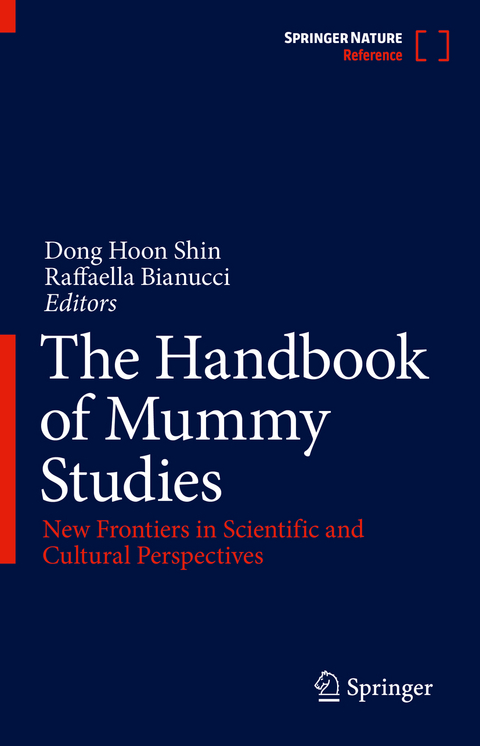
The Handbook of Mummy Studies
Springer Verlag, Singapore
978-981-15-3353-2 (ISBN)
Owing to their unique state of preservation, mummies provide us with significant historical and scientific knowledge of humankind’s past. This handbook, written by prominent international experts in mummy studies, offers readers a comprehensive guide to new understandings of the field’s most recent trends and developments. It provides invaluable information on the health states and pathologies of historic populations and civilizations, as well as their socio-cultural and religious characteristics. Addressing the developments in mummy studies that have taken place over the past two decades – which have been neglected for as long a time – the authors excavate the ground-breaking research that has transformed scientific and cultural knowledge of our ancient predecessors. The handbook investigates the many new biotechnological tools that are routinely applied in mummy studies, ranging from morphological inspection and endoscopy to minimally invasive radiological techniques that are used to assess states of preservation. It also looks at the paleoparasitological and pathological approaches that have been employed to reconstruct the lifestyles and pathologic conditions of ancient populations, and considers the techniques that have been applied to enhance biomedical knowledge, such as craniofacial reconstruction, chemical analysis, stable isotope analysis and ancient DNA analysis. This interdisciplinary handbook will appeal to academics in historical, anthropological, archaeological and biological sciences, and will serve as an indispensable companion to researchers and students interested in worldwide mummy studies.
Dong Hoon Shin graduated from Seoul National University College of Medicine in South Korea and received his certification of geriatrician. After serving as a public physician for three years, he earned his Ph.D. in Anatomy. He currently teaches and researches as a full professor and chairperson in the Department of Anatomy and Cell Biology at Seoul National University. Over the years, his research interests have mainly focused on acquiring scientific information on premodern peoples’ health and disease status. Using research techniques and tools ranging from the anatomical and histological to the molecular, he has worked to reveal the physical and/or pathological traits of ancient peoples and their patterns at different historical stages. He has conducted viral, bacterial, and helminthic pathogen investigations with archaeologically obtained human remains such as Korean mummies. These have afforded vivid glimpses of premodern peoples’ health and disease status and, thus, of their actual lives, in significant detail from both medical and sociocultural perspectives. To enrich his understanding of human diseases of the past, he is also actively joining in fieldwork at archaeological sites outside South Korea. Currently, they include the Indus Valley Civilization ruins of presentday India and the permafrost burial grounds of West Siberia. Based on his academic achievements, he was inducted as a National Geographic Explorer and Kavli Frontiers of Science Fellow Raffaella Bianucci has specialized in biological anthropology, palaeopathology, and medical history with an emphasis on reconstructing the impact of historical plague pandemics in Europe between the sixth and eighteenth centuries. She is known for her pioneering work on the identification of Yersinia pestis F1 protein in ancient skeletal remains. Her researches have contributed significant insights into the systematic identification of putative plague victims uncovered from several plague pits scattered around Europe. She currently is investigating the historical impact of plague on Medieval populations and the biological role of rats and rat fleas in the interhuman transmission of the infection. As a palaeopathologist, her research has focused on the reconstruction of illnesses of several members of important families in Renaissance Italy (the Medici and the Aragonese). By applying the most advanced techniques in medicine and biochemistry, she is investigating the cause of death and the embalming techniques used to preserve ancient Egyptian mummies. Currently she is the group leader of a multidisciplinary project on Spanish church mummies from Quinto (Zaragoza) and on bog bodies from the Netherlands. From 2015, she has specialized in Medical Humanities. Together with Prof. Francesco Maria Galassi (Flinders University, Adelaide, Australia), she has introduced in Italy a new branch of investigation, namely palaeopathography, in classical palaeopathology. Palaeopathography encompasses both the philological and clinical analysis of ancient documental sources and archives and the clinical investigation of ancient works of art with the purpose of identifying the historical presentation and evolution of diseases throughout history. She has published numerous peer-reviewed articles in leading scientific journals such as Nature Communications, The Lancet, The Lancet Oncology, The Lancet Respiratory Medicine, The Lancet Neurology, The Lancet Diabetes and Endocrinology, the American Journal of Medicine, Chest, the American Journal of Physical Anthropology, the Journal of Archaeological Science, PlOS Pathogens, and PlOS ONE. Currently, she is the coeditor and author of a book on Art and Medicine in the xvi About the Editors Uffizi Gallery (Pontercoboli Editore) which will be published in December 2021. Raffaella Bianucci is Vice President of the New Mexico Health Enhancement and Marathon Clinics Research Foundation, Albuquerque (NM, USA) and Honorary Research fellow at Warwick Medical School, Biomedical Sciences, The University of Warwick (UK). She gained her Ph.D. at the University of Florence and completed her postdoctoral training at the universities of Turin (Italy) and Oslo (Norway).
Part 1: Mummy Studies in General.- Part 2: Techniques and Current Trends in Mummy Studies.- Part 3: Mummies of the World.- Part 4: Museology of Mummies.
| Erscheinungsdatum | 29.11.2021 |
|---|---|
| Reihe/Serie | The Handbook of Mummy Studies |
| Zusatzinfo | 290 Illustrations, color; 78 Illustrations, black and white; XXV, 1186 p. 368 illus., 290 illus. in color. In 2 volumes, not available separately. |
| Verlagsort | Singapore |
| Sprache | englisch |
| Maße | 155 x 235 mm |
| Themenwelt | Geschichte ► Allgemeine Geschichte ► Vor- und Frühgeschichte |
| Naturwissenschaften ► Biologie ► Zoologie | |
| Sozialwissenschaften ► Ethnologie | |
| Sozialwissenschaften ► Soziologie | |
| ISBN-10 | 981-15-3353-9 / 9811533539 |
| ISBN-13 | 978-981-15-3353-2 / 9789811533532 |
| Zustand | Neuware |
| Haben Sie eine Frage zum Produkt? |
aus dem Bereich


